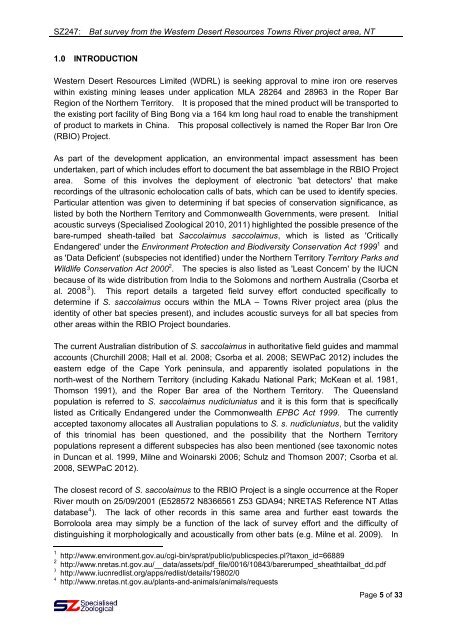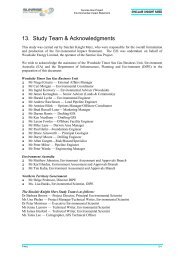Appendix D Terrestrial and Aquatic Biodiversity - Environment ...
Appendix D Terrestrial and Aquatic Biodiversity - Environment ...
Appendix D Terrestrial and Aquatic Biodiversity - Environment ...
Create successful ePaper yourself
Turn your PDF publications into a flip-book with our unique Google optimized e-Paper software.
SZ247: Bat survey from the Western Desert Resources Towns River project area, NT<br />
1.0 INTRODUCTION<br />
Western Desert Resources Limited (WDRL) is seeking approval to mine iron ore reserves<br />
within existing mining leases under application MLA 28264 <strong>and</strong> 28963 in the Roper Bar<br />
Region of the Northern Territory. It is proposed that the mined product will be transported to<br />
the existing port facility of Bing Bong via a 164 km long haul road to enable the transhipment<br />
of product to markets in China. This proposal collectively is named the Roper Bar Iron Ore<br />
(RBIO) Project.<br />
As part of the development application, an environmental impact assessment has been<br />
undertaken, part of which includes effort to document the bat assemblage in the RBIO Project<br />
area. Some of this involves the deployment of electronic 'bat detectors' that make<br />
recordings of the ultrasonic echolocation calls of bats, which can be used to identify species.<br />
Particular attention was given to determining if bat species of conservation significance, as<br />
listed by both the Northern Territory <strong>and</strong> Commonwealth Governments, were present. Initial<br />
acoustic surveys (Specialised Zoological 2010, 2011) highlighted the possible presence of the<br />
bare-rumped sheath-tailed bat Saccolaimus saccolaimus, which is listed as 'Critically<br />
Endangered' under the <strong>Environment</strong> Protection <strong>and</strong> <strong>Biodiversity</strong> Conservation Act 1999 1 <strong>and</strong><br />
as 'Data Deficient' (subspecies not identified) under the Northern Territory Territory Parks <strong>and</strong><br />
Wildlife Conservation Act 2000 2 . The species is also listed as 'Least Concern' by the IUCN<br />
because of its wide distribution from India to the Solomons <strong>and</strong> northern Australia (Csorba et<br />
al. 2008 3 ). This report details a targeted field survey effort conducted specifically to<br />
determine if S. saccolaimus occurs within the MLA – Towns River project area (plus the<br />
identity of other bat species present), <strong>and</strong> includes acoustic surveys for all bat species from<br />
other areas within the RBIO Project boundaries.<br />
The current Australian distribution of S. saccolaimus in authoritative field guides <strong>and</strong> mammal<br />
accounts (Churchill 2008; Hall et al. 2008; Csorba et al. 2008; SEWPaC 2012) includes the<br />
eastern edge of the Cape York peninsula, <strong>and</strong> apparently isolated populations in the<br />
north-west of the Northern Territory (including Kakadu National Park; McKean et al. 1981,<br />
Thomson 1991), <strong>and</strong> the Roper Bar area of the Northern Territory. The Queensl<strong>and</strong><br />
population is referred to S. saccolaimus nudicluniatus <strong>and</strong> it is this form that is specifically<br />
listed as Critically Endangered under the Commonwealth EPBC Act 1999. The currently<br />
accepted taxonomy allocates all Australian populations to S. s. nudicluniatus, but the validity<br />
of this trinomial has been questioned, <strong>and</strong> the possibility that the Northern Territory<br />
populations represent a different subspecies has also been mentioned (see taxonomic notes<br />
in Duncan et al. 1999, Milne <strong>and</strong> Woinarski 2006; Schulz <strong>and</strong> Thomson 2007; Csorba et al.<br />
2008, SEWPaC 2012).<br />
The closest record of S. saccolaimus to the RBIO Project is a single occurrence at the Roper<br />
River mouth on 25/09/2001 (E528572 N8366561 Z53 GDA94; NRETAS Reference NT Atlas<br />
database 4 ). The lack of other records in this same area <strong>and</strong> further east towards the<br />
Borroloola area may simply be a function of the lack of survey effort <strong>and</strong> the difficulty of<br />
distinguishing it morphologically <strong>and</strong> acoustically from other bats (e.g. Milne et al. 2009). In<br />
1 http://www.environment.gov.au/cgi-bin/sprat/public/publicspecies.pl?taxon_id=66889<br />
2 http://www.nretas.nt.gov.au/__data/assets/pdf_file/0016/10843/barerumped_sheathtailbat_dd.pdf<br />
3 http://www.iucnredlist.org/apps/redlist/details/19802/0<br />
4 http://www.nretas.nt.gov.au/plants-<strong>and</strong>-animals/animals/requests<br />
Page 5 of 33



